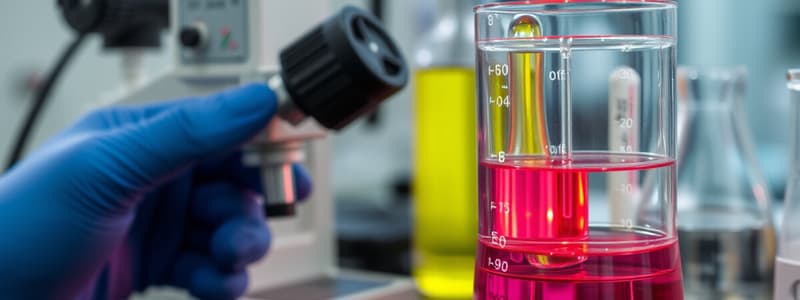Podcast
Questions and Answers
Which test is used to measure agility in athletes?
Which test is used to measure agility in athletes?
- Physical Health Evaluations
- Hexagonal Agility Test (correct)
- Balance Assessment
- Stick Drop Test
The Stick Drop Test assesses an individual's balance.
The Stick Drop Test assesses an individual's balance.
False (B)
Name the test that consists of a series of movements around a hexagonal pattern to evaluate agility.
Name the test that consists of a series of movements around a hexagonal pattern to evaluate agility.
Hexagonal Agility Test
In balance assessments, individuals often perform activities such as standing on one ______.
In balance assessments, individuals often perform activities such as standing on one ______.
What is the purpose of the Stick Drop Test?
What is the purpose of the Stick Drop Test?
Match the physical fitness tests with what they measure:
Match the physical fitness tests with what they measure:
The Hexagonal Agility Test measures the strength of an individual.
The Hexagonal Agility Test measures the strength of an individual.
What is an important component of physical fitness that affects everyday activities?
What is an important component of physical fitness that affects everyday activities?
What are the three measurements taken in the Push-Up test?
What are the three measurements taken in the Push-Up test?
Physical health evaluations are solely focused on performance in agility tests.
Physical health evaluations are solely focused on performance in agility tests.
In a 40-Meter Sprint test, the time is recorded in __________.
In a 40-Meter Sprint test, the time is recorded in __________.
What term describes the ability to maintain stability and control of the body's position?
What term describes the ability to maintain stability and control of the body's position?
Match the following fitness assessments with their respective categories:
Match the following fitness assessments with their respective categories:
Which of the following is NOT a component measured during health-related fitness evaluations?
Which of the following is NOT a component measured during health-related fitness evaluations?
In order to classify BMI, weight is divided by height in meters squared.
In order to classify BMI, weight is divided by height in meters squared.
What are the measurements taken in the Standing Long Jump test?
What are the measurements taken in the Standing Long Jump test?
What is the primary purpose of push-ups in fitness testing?
What is the primary purpose of push-ups in fitness testing?
In push-ups, girls are required to keep their knees off the mat while performing the exercise.
In push-ups, girls are required to keep their knees off the mat while performing the exercise.
What equipment do you need to perform a push-up test?
What equipment do you need to perform a push-up test?
In the standard push-up position, the palms should be placed under the ______.
In the standard push-up position, the palms should be placed under the ______.
Match the following types of physical fitness assessments with their characteristics:
Match the following types of physical fitness assessments with their characteristics:
During the push-up, at what angle should the elbows be when the arms are lowered?
During the push-up, at what angle should the elbows be when the arms are lowered?
Both boys and girls perform push-ups with the same body position.
Both boys and girls perform push-ups with the same body position.
What should the body position look like during a standard push-up?
What should the body position look like during a standard push-up?
Flashcards are hidden until you start studying
Study Notes
Health-Related Fitness Assessment
- Subjects should indicate readiness to begin fitness assessments.
- Distance fallen by the ruler is recorded in meters.
- Each assessment should be repeated three times for accuracy.
Personal Information for Assessment
- Participants must provide personal details including name, birthdate/age, sex, class time, days, and course/year/section.
Part I – Health-Related Fitness
Body Composition: BMI
- Calculate BMI using height in meters and weight in kilograms.
- Classification of BMI to identify weight category.
Cardiovascular Endurance: Three-Minute Step Test
- Resting heart rate measured at rest.
- Training heart rate captured immediately after activity.
- Recovery heart rate recorded after one minute of rest.
Strength Test: Push-up
- Number of push-ups performed is recorded.
Flexibility Test: Sit & Reach
- Three trials conducted: first, second, and final scores recorded in centimeters.
Part II – Skill-Related Fitness Tests
Speed Test: 40-Meter Sprint
- Time taken to complete the sprint recorded in minutes and seconds format.
Power Test: Standing Long Jump
- Distance jumped recorded in centimeters, with second trial and final trial distances noted.
Agility Test: Hexagonal Agility Test
- Time taken to complete the test counterclockwise recorded.
- Average time calculated from trials.
Reaction Time Test: Stick Drop Test
- Three trials conducted with middle score recorded for assessment.
Evaluation Rubrics for Physical Fitness Tests
- Body Mass Index calculated as weight (kg) divided by height (m²).
Course Information
- Affiliated with the College of Teacher Education, Bayombong Campus.
- Degree programs encompass all fields, specifically in the course titled "Physical Activities Towards Health & Fitness 1."
- Designed for first-year students, spanning a time frame of four hours for weeks 3 and 4.
Unit Title and Learning Objectives
- Focus on Unit II: Physical Fitness, encompassing components and tests.
- Students will learn the significance of physical fitness and conduct various fitness tests to monitor personal health.
Lesson Overview and Desired Learning Outcomes
- Lesson content introduces components of physical fitness and the rationale behind fitness testing.
- Students should be able to discuss the components and perform physical fitness tests effectively.
Studying That Suits You
Use AI to generate personalized quizzes and flashcards to suit your learning preferences.




